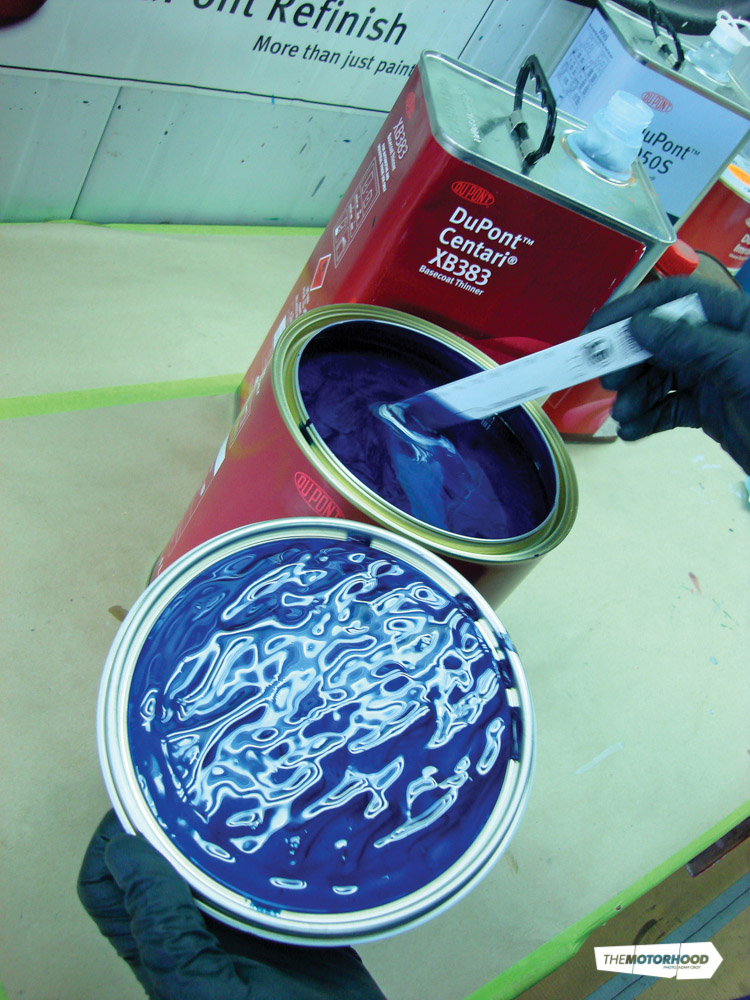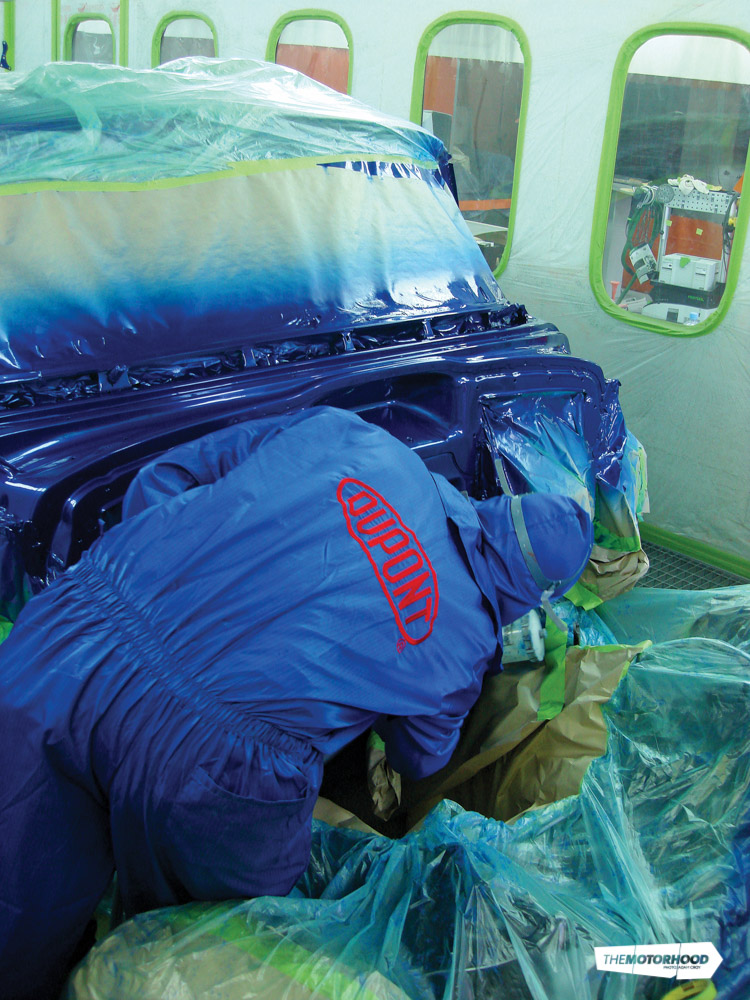“Think that painting a car just involves sanding it back and blowing it over? Think again, as there’s a whole lot more to it than that”
Previously we followed the team from Resene Automotive and Light Industrial (RALI) as they took a beaten-up cruiser with extremely worn paint and got it into primer in preparation for painting. It was a long and involved process, but one that was made easier by having access to the right products and expertise. The team at RALI are New Zealand’s suppliers of DuPont Refinish products, so it’s these products that have been used throughout the process so far.
Getting the body straight is the time-consuming part of the painting process, even though it’s the one with the least visual effect. The quality of the preparation is essential however, as that’s what the paint itself will be adhering to, and any imperfections will greatly reduce the quality and longevity of the finish. Of course before we can even think of applying any colour, we need to sort out what the colour is going to be.
Due to the unique way in which DuPont paints feature a Value Shade system — a range of primers that make the topcoat perform better — we actually had to decide the colour before the vehicle was primed.
Picking a colour is always an exciting, although somewhat nervous time. We knew roughly what we were after though, and after discussing with RALI’s specialist colour mixer Andrew Town, we were all on the same page. A couple of spray-outs later and it was a done deal. What made choosing the colour relatively simple was the way that DuPont paints are supplied. Each colour is required to be mixed with the correct activator based on its application purpose. For example, painting onto plastic you’d mix the colour with a plastic activator, whereas onto something exposed to extreme temperatures, such as an engine block, you’d use a high temperature binder. This allows any colour to be used for any purpose without fear of the final shade varying from surface to surface.
As with any paint colour, the final choice was created using a range of tinters and metallics. While it’s common to have five or six different ‘ingredients’, the chosen colour (dubbed ‘Boogie Blue’ by Andrew) is in fact remarkably simple with just a couple of different tinters. What gives the colour its different hues is the Xirallic pearl, similar to that found on many late-model vehicles. In the sunlight the Xirallic comes to life and really makes the colour pop, while in the shade it looks a lot darker. Under artificial light it looks completely different again. This is why it’s always important to choose your colour on a sunny day, so you can see it in all lights.
To keep impurities to a minimum, colours should always be mixed in a dedicated ‘tint room’, which in most paint shops you’ll find is attached to the side of the spray booth. With the colour sorted, the task of getting it onto the vehicle can begin — although it’s not as easy as simply pushing the car into the booth and pulling the trigger.
For an even finish with no build-up on the end of each spray stroke, it’s essential for the panels that have been removed from the vehicle — such as the boot lid, bonnet and doors — to be re-fitted. Of course, the problem with this is that you then can’t access the door, boot and bonnet jambs. It’s with this in mind that the jambs and closing faces of the doors, etc. must get painted prior to the panels being hung back on.
For this, the car itself is masked up leaving just the areas requiring paint exposed. Again, while it may sound like a simple task, the masking lines must be in the correct place so as not to create a visible ‘sharp edge’. Great care is also taken not to end up with overspray in the interior of the vehicle, or on any other surface where it’s unwanted.
With masking complete, the exposed surfaces are wiped down with a solvent to remove any greasy fingerprints, etc. which may have been left during the masking process.
And now, finally it’s time to prepare the paint itself. The correctly coloured DuPont Centari 6000 is mixed with DuPont BK220 Chip Protector and reduced with DuPont XB383/XB387 Reducer. The addition of BK220 to the basecoat not only gives the paint greater stone chip resistance, but also helps the inter-coat adhesion.
The mixing ratio for the Centari basecoat is 2.7 parts colour to 0.3 parts BK220, which is then reduced with 1 part XB383/XB387 Reducer (thinners). The mixed product must be viscosity checked, which is done by using a special viscosity cup along with a stopwatch.
With the paint now activated, time is of the essence, as the paint will begin to harden. The activated basecoat is applied to achieve opacity, which depending on the colour chosen is usually 2–3 coats. In the case of the Boogie Blue it was three. Without the Value Shade primer, to achieve the same opacity you’d be looking at five coats or more. Each coat must be allowed to ‘flash off’ before subsequent coats are applied. The flash time lets the solvents escape from the paint, allowing it to dry and adhere to the surface correctly.
In the case of the Cadillac, it was decided that as well as the doorjambs, the firewall and roof also needed to be painted at this stage — the firewall due to the fact that the engine could not be re-fitted with the front guards and radiator support panel reinstalled, and the roof due to its sheer size requiring the painter to stand on the door sills to reach the centre. Obviously this made the roof the starting point, as once the sills were painted, they couldn’t be stepped on without causing damage.
With three coats of colour on all of the exposed areas, it was left to dry for 15 minutes with a booth temperature of 22–25 degrees. Once deemed appropriate, DuPont 3050S ChromaClear clearcoat is applied. The DuPont 3050S is a two-component clearcoat, which is part of DuPont’s Low Emission range of products. It’s mixed at a ratio of 4:1 with XK206 Activator and does not require reducer. The mixed clearcoat is applied in two full coats, leaving at least five minutes between coats to flash off, and then left to dry in the booth overnight. The clearcoat can be force dried, or baked to speed up the drying process, but this may have an impact on the gloss level.
With the panels refitted to the car (and in this case the engine too, but more on that next issue) it was finally time for the car to go into the booth for one last time! It’s always fun to watch your car go into the spray booth, and always exciting to see it change colour right before your eyes. RALI uses a high-quality downdraft heated booth, but to ensure minimal airborne contamination a new plastic lining was applied to the walls before the car was wiped down with solvent.
As with when the jambs were painted, careful masking was required. While 3M tape, and plenty of brown paper and specialist plastic sheets are used for the majority of the job.
A special foam ‘soft edge’ is used between the doors and the frames. This is to stop any harsh lines from occurring during the spray process.
Once the car is wiped down, the DuPont Centari is once again mixed with Activator and Reducer, and when poured into the spray gun it’s filtered through an extremely fine paper filter to extract any impurities.
Every painter has a different style when painting a car. RALI’s painter Andrew started at the bottoms of the rocker panels and worked his way up. A steady hand and consistent speed are essential for a streak-free finish.
Each DuPont Centari topcoat requires around 15 minutes to flash off before the next coat is applied — which, on a car like this, is about how long it takes to get around it whilst spraying. With the booth temperature set at 23oC, it’s a warm and tiring job, especially when wearing the appropriate safety gear. After allowing the topcoat to dry for 15 minutes it’s once again time to apply the DuPont 3050S ChromaClear clearcoat. As with the doorjambs and roof, it’s mixed to a ratio of 4:1.
Unwrapping the car from its masking is like unwrapping a giant Christmas present. And while you can picture in your head what it will look like, seeing it in the flesh is really something else. But, the process isn’t complete yet.
Depending on the quality of the finish achieved so far, the next step is either to buff it, or to flow-coat it. Flow-coating involves sanding back the clear before applying another single clearcoat with a different mixing ratio. In the case of the Cadillac, the quality of the paintwork straight off the gun was exceptional, so it was decided that a buff would suffice. Nothing’s ever as easy as it sounds though, and that includes buffing a freshly painted car.
It’s a three-step process; the first being to sand back the whole body with 2000-grit wet and dry sandpaper. Putting scratch marks into fresh paint may seem like a bad idea; however, they’re soon removed, and the surface will end up better for it.
The next step is to use an electric orbital sander with 3000-grit 3M Trizact pad, which features an engineered surface of microscopic three-dimensional structures resembling pyramids. (9) This precise and consistent abrasive surface is perfect for creating a fine finish. The process is still far from complete though, as there are three further stages of buffing to go, with the finishing surfaces becoming finer at each stage. It’s a process that sounds simple, but in reality requires a few days of continual buffing, which is obviously no easy task. If you’re aiming for a top quality, peel-free finish, it’s essential though, no matter how good the paintwork is ‘off the gun’.
As well as plenty of attention to detail, having the right [quality] products and a decent working environment are essential to creating a flawless finish. In the case of the Cadillac, all three boxes were well and truly ticked by the team at RALI with their DuPont Refinish range of products, and the results speak for themselves.
Of course, the car is still a long way from finished, as there are still plenty of small bits requiring painting and a range of other treatments necessary, which we’ll show you next issue.
This tech article was featured in NZV8 Issue No. 86 (July 2012). You can grab a copy here.
















